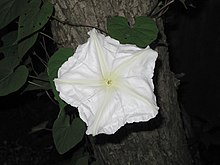
Summary
Ipomoea alba, sometimes called the tropical white morning-glory, moonflower or moon vine, is a species of night-blooming morning glory, native to tropical and subtropical regions of North and South America, from Argentina to northern Mexico, Arizona, Florida[3] and the West Indies.[4] Though formerly classified as genus Calonyction, species aculeatum, it is now properly assigned to genus Ipomoea, subgenus Quamoclit, section Calonyction.[5]
| Ipomoea alba | |
|---|---|

| |
| Scientific classification | |
| Kingdom: | Plantae |
| Clade: | Tracheophytes |
| Clade: | Angiosperms |
| Clade: | Eudicots |
| Clade: | Asterids |
| Order: | Solanales |
| Family: | Convolvulaceae |
| Genus: | Ipomoea |
| Species: | I. alba
|
| Binomial name | |
| Ipomoea alba | |
Description edit
Ipomoea alba is a perennial, herbaceous liana growing to a height of 5–30 m (16–98 ft) tall with twining stems. The leaves are entire or three-lobed, 5–15 cm (2.0–5.9 in) long, with a 5–20 cm (2.0–7.9 in) long stem. The flowers are fragrant, white or pink, and large, 8–14 cm (3.1–5.5 in) diameter. The flowers open quickly in the evening and last through the night, remaining open until touched by the morning dew. On overcast days, the blossoms may remain open for longer. The flowers also tend to remain open longer during cool temperatures, which may also cause the segments to snag or tear as they open.
The name moonflower derives from their blooming in the evening and their being round in shape like a full moon.
Historical use edit
The Mesoamerican civilizations used the Ipomoea alba morning glory to convert the latex from the Castilla elastica tree to produce bouncing rubber balls. The sulfur in this morning glory served to cross-link the rubber, a process predating Charles Goodyear's discovery of vulcanization by at least 3,000 years.[6]
Cultivation edit
The species is widely cultivated as an ornamental plant for its flowers. In areas too cold for winter survival, it can be grown as an annual plant. Since it is of tropical origin, it flowers best under a summer short day photoperiod. Though it can be successfully flowered in the north, its flowering is impaired by excessively long summer days. Thus, it often does not set buds and bloom until early autumn when daylight length is once again near 12 hours. Propagation is usually by seed. The seed resembles a small, brownish nut, and should be nicked with a file and then soaked overnight before planting. In some areas, it is an invasive species which can cause problems in agricultural settings.
References edit
- ^ Canteiro, C. (2021). "Ipomoea alba". IUCN Red List of Threatened Species. 2021: e.T126421388A158506713. doi:10.2305/IUCN.UK.2021-1.RLTS.T126421388A158506713.en. Retrieved 18 November 2021.
- ^ NatureServe (2024). "Ipomoea alba". Arlington, Virginia. Retrieved 15 February 2024.
- ^ And Bly USDA, NRCS (n.d.). "Ipomoea alba". The PLANTS Database (plants.usda.gov). Greensboro, North Carolina: National Plant Data Team. Retrieved 20 May 2015.
- ^ Liogier, A.H.; Liogier, H.A.; Martorell, L.F. (2000). Flora of Puerto Rico and Adjacent Islands: A Systematic Synopsis. Ed. de la Universidad. p. 163. ISBN 978-0-8477-0369-2. Archived from the original on 28 July 2022. Retrieved 7 January 2020.
- ^ "Ipomoea alba". Germplasm Resources Information Network. Agricultural Research Service, United States Department of Agriculture. Retrieved 17 December 2017.
- ^ "Rubber processed in ancient Mesoamerica, MIT researchers find". MIT News. Archived from the original on 2005-04-25. Retrieved 2017-12-08.




